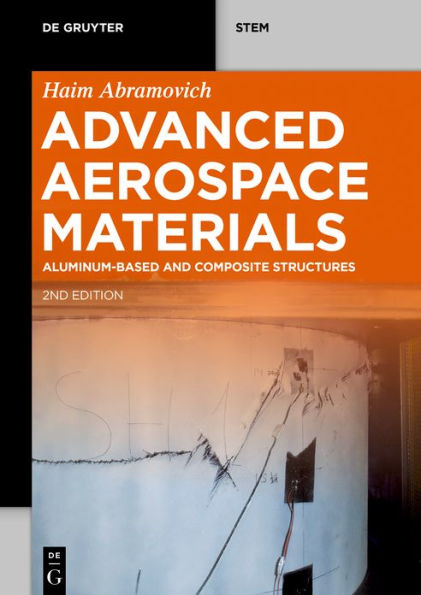Table of Contents
Preface V
1 Introduction 1
1.1 Introduction 1
1.2 Aerospace structures 1
1.3 Aerospace structures - transition to composite materials 5
1.4 Basic topics in elasticity 9
1.4.1 Stresses, strains and rigid body rotations 9
1.4.2 Equilibrium and compatibility equations in elasticity 15
1.4.3 Plane stress and plane strain (2D representations) 21
1.4.4 The Airy function φ(x,y) 25
1.4.5 Thermal field 27
References 28
2 Composite materials 30
2.1 Introduction 30
2.1.1 General introduction 30
2.2 Unidirectional composites 31
2.3 Properties of a single ply 35
2.4 Transformation of stresses and strains 36
2.5 The classical lamination theory 39
2.6 First-order shear deformation theory 46
2.7 Higher order theories 51
References 66
3 Design formulas 69
3.1 Introduction 69
3.2 Airy functions 69
3.3 Distribution of the shear forces, moments, deflections and slopes for beams 69
3.4 Natural frequencies for common basic structures 70
3.5 Torsion of bars 81
References 86
4 Introduction to fatigue 87
4.1 Introduction 87
4.2 Definition of fatigue 87
4.2.1 Basic fatigue concepts 87
4.2.2 The four steps of fatigue failure 90
4.3 The S-N curve 91
4.3.1 The probability distributions for fatigue life 93
4.3.2 Fatigue life for various combinations of alternating and mean stresses 95
4.4 Miner rule - the cumulative damage 97
4.5 Fatigue of composite materials 97
References 101
Appendix A Application of Fig. 4.6 and its associated equations 103
5 Introduction to crack propagation analysis 105
5.1 Introduction 105
5.2 Foundations of fracture mechanics 105
5.2.1 Introductory concepts 105
5.2.2 Basic failure modes 107
5.2.3 The stress intensity factor, K 108
5.2.4 The energy release rate, G 109
5.2.5 The J-integral 111
5.2.6 The crack opening displacement 112
5.2.7 Some closure notes 112
5.3 Fatigue crack propagation 112
5.3.1 Introductory concepts 112
5.3.2 The Paris law 113
5.3.3 Experimental fracture mechanics 115
References 119
6 Buckling of thin-walled structures 121
6.1 Introduction 121
6.2 Buckling of columns 121
6.2.1 Euler buckling 121
6.2.2 Rankin-Gordon formula 124
6.2.3 Composite columns- CLT approach 125
6.3 Buckling of columns - FSDT approach 133
6.4 Buckling of plates 138
6.4.1 Buckling of isotropic plates 138
6.4.2 Buckling of orthotropic plates 143
References 148
Appendix A Nonsymmetric laminated composite beam - CLT approach 150
7 Vibrations of thin-walled structures 153
7.1 Introduction 153
7.1.1 CLPT approach 153
7.1.2 FSDPT approach 155
7.2 Vibrations of columns - CLT approach 157
7.2.1 Symmetric laminate (B11 = 0, I1 - 0) 157
7.2.2 Nonsymmetric laminate (B11 ≠, I1 ≠ 0) 162
7.3 Vibrations of columns - FSDT approach 163
7.3.1 Symmetric laminate (B11 = 0, I1 = 0) 164
7.3.2 Nonsymmetric laminate (B11 ≠ 0, I1 ≠ 0) 166
7.4 Vibrations of plates - CLPT approach 170
7.4.1 Simply supported special orthotropic plates 170
7.4.2 Simply supported on two opposite edges of special orthotropic plates 171
References 172
Appendix A General solution for a nonsymmetrical beam resting on any boundary conditions 173
Appendix B Matrix notation for the equilibrium equations using CLT approach 175
Appendix C The terms of the matrix notation for the equilibrium equations using FSDPT approach 176
8 Dynamic buckling of thin-walled structures 177
8.1 Introduction 177
8.2 Dynamic buckling of columns 181
8.2.1 Dynamic buckling of columns using CLT 181
8.2.2 Dynamic buckling of columns using FSDT 184
8.3 Dynamic buckling of plates 186
8.4 Dynamic buckling of thin-walled structures - numerical and experimental results 191
References 201
Appendix A Calculation of the critical buckling load of a uniaxial loaded plate from test results 203
9 Optimization of thin-walled structures 205
9.1 Introduction 205
9.2 The optimization process 206
9.2.1 Vocabulary and concepts 206
9.3 Structural optimization 209
9.4 Multidisciplinary and multiobjective design optimization 209
9.5 Methods of optimization 211
9.6 Classical optimization techniques 211
9.7 Numerical methods of optimization 212
9.7.1 Linear programming 213
9.7.2 Integer programming 214
9.7.3 Nonlinear programming 214
9.7.4 Quadratic programming 215
9.7.5 Stochastic programming 215
9.7.6 Dynamic programming 215
9.8 Advanced optimization techniques 216
9.8.1 Hill climbing 216
9.8.2 Simulated annealing 217
9.8.3 Genetic algorithms 217
9.8.4 Ant colony optimization 218
9.8.5 Neural network optimization 218
9.9 Gradient-based methods 219
9.9.1 Unconstrained methods 219
9.9.2 Constrained methods 220
9.10 Heuristic methods 222
9.10.1 Tabu search 222
9.11 Optimization of topology of aerospace structures 223
9.12 History of topology optimization 224
9.13 Density-based methods 225
9.14 Hard-kill methods 229
9.14.1 Evolutionary structural optimization methods 229
9.15 Boundary variation methods 231
9.15.1 Level-set methods 232
9.15.2 Phase field method 233
9.16 Recently developed methods 235
9.16.1 Bio-inspired cellular division-based method 235
9.17 Applications in the aerospace field 237
9.17.1 General topology optimization applications 237
9.17.2 Applications of density-based methods 237
9.17.3 Applications of hard-kill methods 238
9.17.4 Applications of boundary variation methods 238
9.17.5 Applications of bio-inspired cellular division-based method 239
9.18 Conclusions 239
References 240
Appendix A Response surface methodology 243
10 Structural health monitoring (SHM) 272
10.1 Introduction 272
10.1.1 Diagnosis 273
10.1.2 Damage prognosis 274
10.1.3 Predictive maintenance 277
10.2 Applications 278
10.2.1 Aerospace applications 278
10.2.2 Civil applications 281
10.2.3 General applications 282
10.3 Monitoring natural frequencies of composite beams for detection of damage 282
References 291
Appendix A Passive and active sensors 294
Index 306



